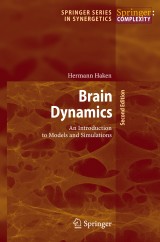Details

Brain Dynamics
An Introduction to Models and SimulationsSpringer Series in Synergetics 2nd ed. 2008
|
CHF 59.00 |
|
| Verlag: | Springer |
| Format: | |
| Veröffentl.: | 22.12.2007 |
| ISBN/EAN: | 9783540752387 |
| Sprache: | englisch |
| Anzahl Seiten: | 333 |
Dieses eBook enthält ein Wasserzeichen.
Beschreibungen
<P><STRONG>Brain Dynamics</STRONG> serves to introduce graduate students and nonspecialists from various backgrounds to the field of mathematical and computational neurosciences. Some of the advanced chapters will also be of interest to the specialists. The book approaches the subject through pulse-coupled neural networks, with at their core the lighthouse and integrate-and-fire models, which allow for the highly flexible modelling of realistic synaptic activity, synchronization and spatio-temporal pattern formation. Topics also include pulse-averaged equations and their application to movement coordination. The book closes with a short analysis of models versus the real neurophysiological system.<BR><BR>The second edition has been thoroughly updated and augmented by two extensive chapters that discuss the interplay between pattern recognition and synchronization. Further, to enhance the usefulness as textbook and for self-study, the detailed solutions for all 34 exercises throughout the text have been added.</P>
Basic Experimental Facts and Theoretical Tools.- The Neuron – Building Block of the Brain.- Neuronal Cooperativity.- Spikes, Phases, Noise: How to Describe Them Mathematically? We Learn a Few Tricks and Some Important Concepts.- Spiking in Neural Nets.- The Lighthouse Model. Two Coupled Neurons.- The Lighthouse Model. Many Coupled Neurons.- Integrate and Fire Models (IFM).- Many Neurons, General Case, Connection with Integrate and Fire Model.- Pattern Recognition Versus Synchronization: Pattern Recognition.- Pattern Recognition Versus Synchronization: Synchronization and Phase Locking.- Phase Locking, Coordination and Spatio-Temporal Patterns.- Phase Locking via Sinusoidal Couplings.- Pulse-Averaged Equations.- Conclusion.- The Single Neuron.- Conclusion and Outlook.- Solutions to Exercises.
<P> <STRONG>Brain Dynamics</STRONG> serves to introduce graduate students and nonspecialists from various backgrounds to the field of mathematical and computational neurosciences. Some of the advanced chapters will also be of interest to the specialists. The book approaches the subject through pulse-coupled neural networks, with at their core the lighthouse and integrate-and-fire models, which allow for the highly flexible modelling of realistic synaptic activity, synchronization and spatio-temporal pattern formation. Topics also include pulse-averaged equations and their application to movement coordination. The book closes with a short analysis of models versus the real neurophysiological system.<BR><BR>The second edition has been thoroughly updated and augmented by two extensive chapters that discuss the interplay between pattern recognition and synchronization. Further, to enhance the usefulness as textbook and for self-study, the detailed solutions for all 34 exercises throughout the text have been added.</P>
Includes supplementary material: sn.pub/extras
Diese Produkte könnten Sie auch interessieren:

Alzheimer's Disease: Cellular and Molecular Aspects of Amyloid beta

von: J. Robin Harris, Falk Fahrenholz

CHF 236.00















